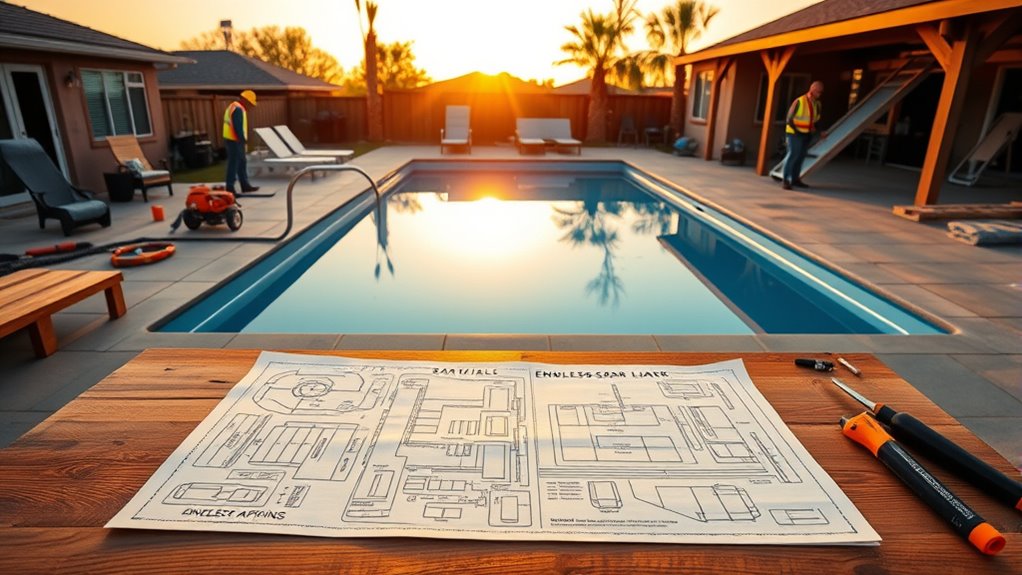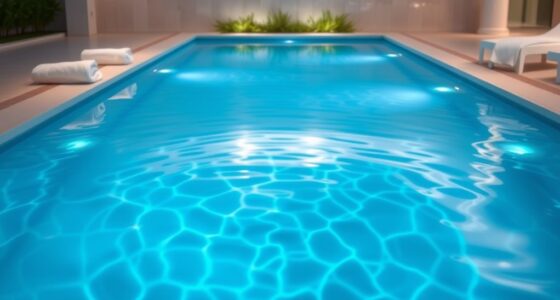To install your endless pool from first sketch to your first swim, start by evaluating your space, budget, and local regulations to ensure proper planning. Prepare the site with a level foundation, and design your pool layout considering size, style, and features. Select suitable equipment, install the infrastructure carefully, and fill the pool while checking for leaks. As you progress, fine-tune the system and monitor maintenance needs — the entire process becomes clearer as you continue on.
Key Takeaways
- Assess space, budget, and local regulations early to ensure a compliant and feasible installation plan.
- Prepare a level foundation with concrete or gravel to support pool stability and longevity.
- Design the pool layout, select durable materials, and choose features that match your aesthetic and functional needs.
- Install plumbing, electrical systems, and support structures carefully, then fill and test the pool for leaks and water quality.
- Conduct final safety checks, schedule maintenance, and keep documentation to ensure long-term safe and enjoyable use.
Assessing Your Space and Setting a Budget
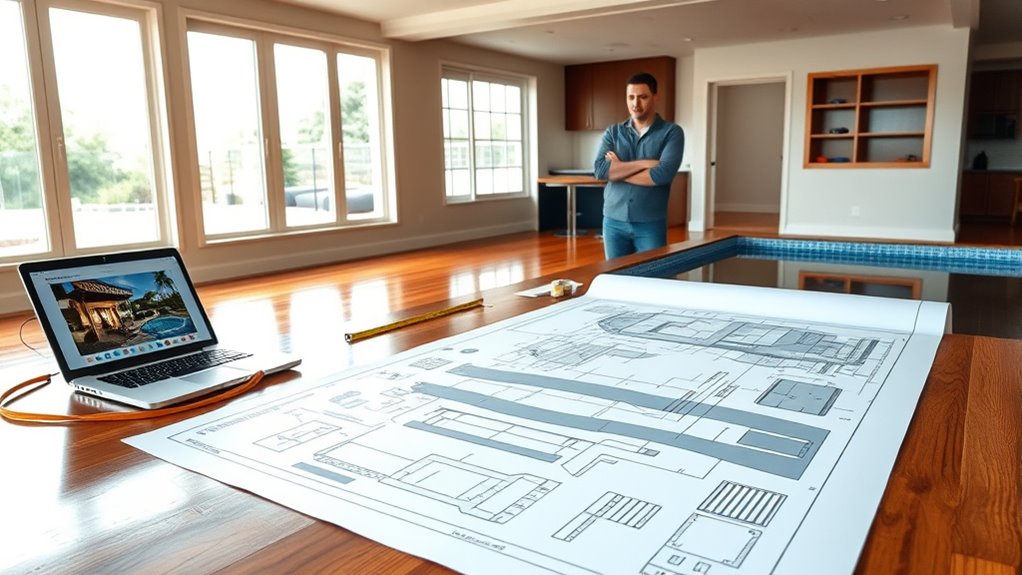
Before you begin planning your pool installation, it’s essential to evaluate your available space and establish a realistic budget. Start by measuring the area where you want to install your endless pool, considering clearances for access, safety, and future maintenance. Keep in mind local regulations and setbacks that might affect your space. Next, determine how much you’re willing to spend, including costs for equipment, permits, and ongoing maintenance. Be honest about your financial limits to avoid overspending. Setting a clear budget upfront helps you prioritize features and avoid unnecessary expenses later. Additionally, understanding the cost of a tiny house can provide insight into potential expenses for land and infrastructure, which may be relevant if your pool is part of a larger property upgrade. Remember, a well-planned budget ensures your project stays on track and that your new pool becomes a long-term investment you’ll enjoy without financial stress.
Designing Your Perfect Endless Pool Layout
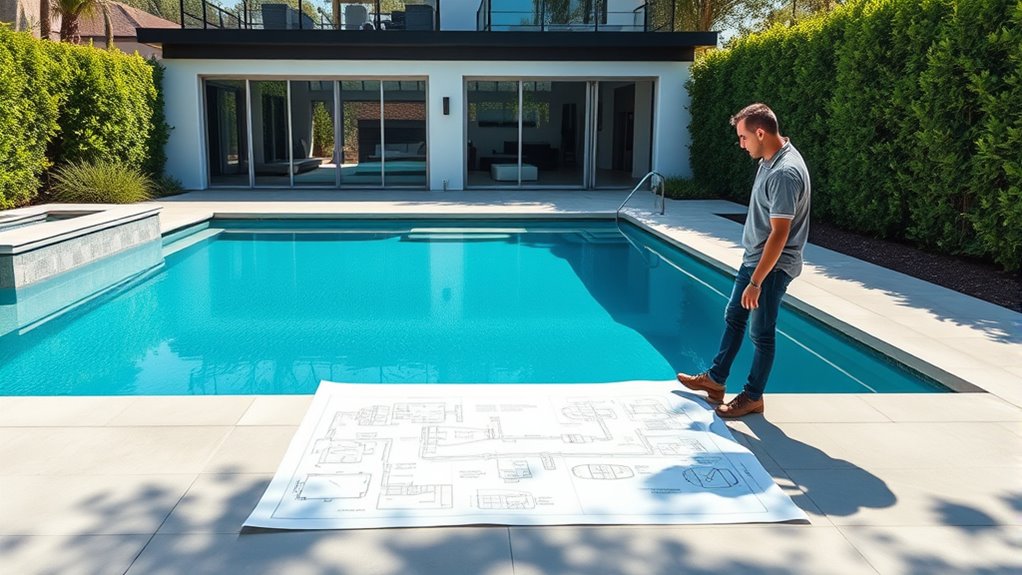
When designing your endless pool layout, consider how your space planning aligns with your lifestyle and available area. Choose style and materials that match your aesthetic while ensuring durability and ease of maintenance. Don’t forget to evaluate pool size options to create a comfortable, functional environment that fits your needs. Incorporating self watering plant pots can help maintain your surrounding landscape with minimal effort, ensuring your outdoor space remains vibrant and inviting.
Space Planning Strategies
Designing your perfect endless pool layout starts with smart space planning that maximizes both functionality and aesthetics. Begin by measuring your available area carefully, considering bedroom elements such as clearance around the pool for easy access and maintenance. Think about traffic flow—ensure there’s enough space for entering, exiting, and moving around comfortably. Position your pool to optimize natural light and privacy, and avoid placing it near trees or structures that could cause debris or shade. Incorporate nearby storage for pool accessories, towels, and cleaning equipment. If you plan outdoor seating or lounging areas, allocate sufficient space without crowding the pool area. Keep utility access in mind for plumbing and electrical connections. Effective space planning guarantees your pool complements your landscape while remaining practical and easy to maintain.
Style and Material Choices
Choosing the right style and materials for your endless pool can transform your outdoor space into a stunning retreat. Consider the overall aesthetic you want—sleek and modern, natural and rustic, or something unique that reflects your personality. For materials, options like fiberglass, acrylic, or concrete each offer different benefits in durability and appearance. Fiberglass pools come pre-formed, making installation quick and easy, while concrete allows for custom shapes and finishes. Think about how the pool will complement your landscape, fencing, and decking. You might choose materials that blend seamlessly with natural surroundings or create a striking contrast. Your style and material choices set the tone for your entire backyard, making it both functional and visually appealing. Incorporating natural elements or textured finishes can further enhance the overall ambiance of your pool area.
Pool Size Considerations
Selecting the right size for your endless pool is essential to create a functional and enjoyable outdoor feature. Consider how you’ll use the pool—if you want to swim laps, a longer, narrower design might be best. For general relaxation and exercise, a square or slightly rectangular shape offers versatility. Think about available space and future needs; a larger pool provides more swimming room but requires more maintenance and space. Keep in mind the number of users and their ages, ensuring there’s enough room for everyone. Smaller pools are easier to maintain and fit into tighter spaces, but may limit activities. Ultimately, balancing your goals, space constraints, and budget will help you choose a size that maximizes enjoyment without sacrificing practicality. Additionally, understanding pool size considerations can help you make an informed decision that aligns with your lifestyle.
Obtaining Permits and Navigating Regulations
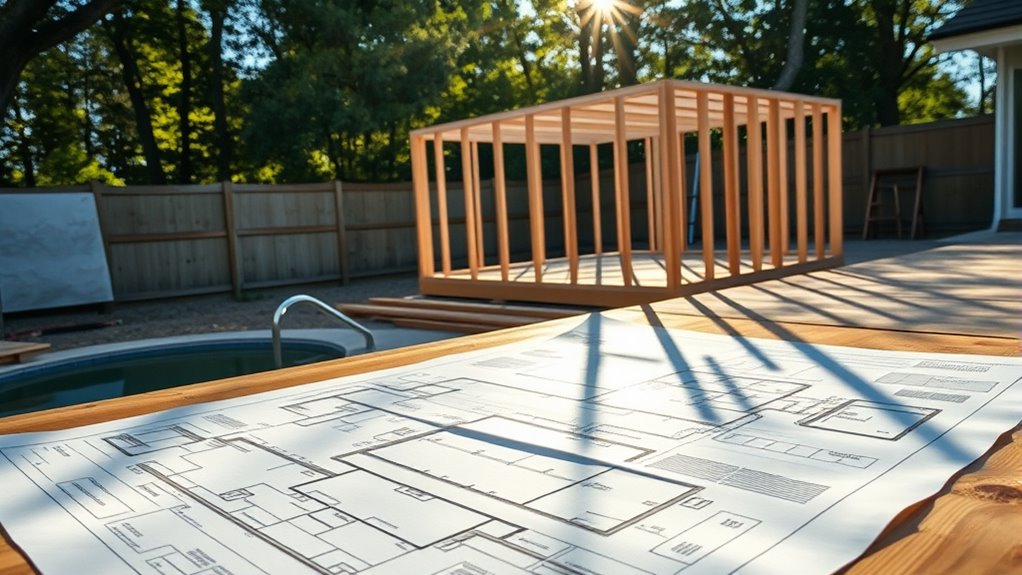
Before you start building, you need to understand the permit requirements in your area. Local rules often include zoning laws and setback distances that could affect your pool’s placement. Managing the approval process guarantees your project stays on track and meets all regulations. Familiarizing yourself with sound design principles can also help in creating a peaceful and enjoyable backyard environment around your pool.
Local Permit Requirements
Guiding local permit requirements is an essential step in your pool installation process, as failing to obtain the necessary approvals can lead to costly delays or fines. You should start by checking with your city or county’s building department to identify specific permits needed for your endless pool. Some jurisdictions require a general building permit, while others may have additional requirements like electrical or plumbing permits. Be prepared to submit detailed plans, including site plans and safety features. Keep in mind that permit fees vary depending on location and pool size. It is vital to apply early, as approval times can range from days to weeks. Staying compliant ensures your project moves smoothly and avoids potential legal or financial issues down the line.
Zoning and Setback Rules
Understanding local zoning laws and setback requirements is a key part of securing permits and ensuring your pool complies with regulations. These rules protect your property, neighbors, and community standards. Before starting construction, review your local ordinances to determine minimum distances from property lines, structures, and utilities. Failing to abide by these can cause costly delays or fines. Use this table to visualize the importance of setbacks:
| Your Property Line | Pool Placement | Neighbor’s Property |
|---|---|---|
| Protects privacy | Ensures safety | Maintains harmony |
| Avoids violations | Prevents encroachment | Preserves relationships |
Adhering to zoning and setback rules guarantees a smooth process, peace of mind, and a beautiful, compliant pool you’ll enjoy for years. Additionally, understanding local regulations related to water features can help prevent potential legal issues before they arise.
Regulatory Approval Process
Guiding the regulatory approval process is a critical step that guarantees your pool project complies with local laws and avoids costly delays. First, research your city or county’s specific requirements, which may include permits for construction, electrical work, or plumbing. Contact your local building department to confirm the necessary paperwork and inspections. Prepare detailed plans, including site diagrams and safety features, to submit with your application. Once approved, schedule inspections at various stages of installation to ensure compliance. Failing to obtain the right permits can lead to fines or having to undo work. Staying proactive and organized throughout this process helps you navigate regulations smoothly and keeps your project on track for a safe, legal, and hassle-free installation. Additionally, understanding building codes and zoning regulations is essential to ensure your pool installation aligns with local policies and avoids future legal issues.
Preparing the Site and Foundation

Before installing your pool, you need to carefully prepare the site and lay a solid foundation. Proper preparation guarantees stability and safety for your Endless Pool. First, clear the area of all debris, rocks, and plants to create a clean workspace. Second, level the ground using a level and a tamper, making sure the surface is flat and even. Third, pour a concrete slab or install a compacted gravel bed to provide a stable base that can support the weight and prevent shifting. Take your time during this step to ensure the site is well-prepared, as this foundation will influence the pool’s longevity and performance. A solid, level foundation makes installation smoother and helps avoid future problems.
Selecting the Right Equipment and Features
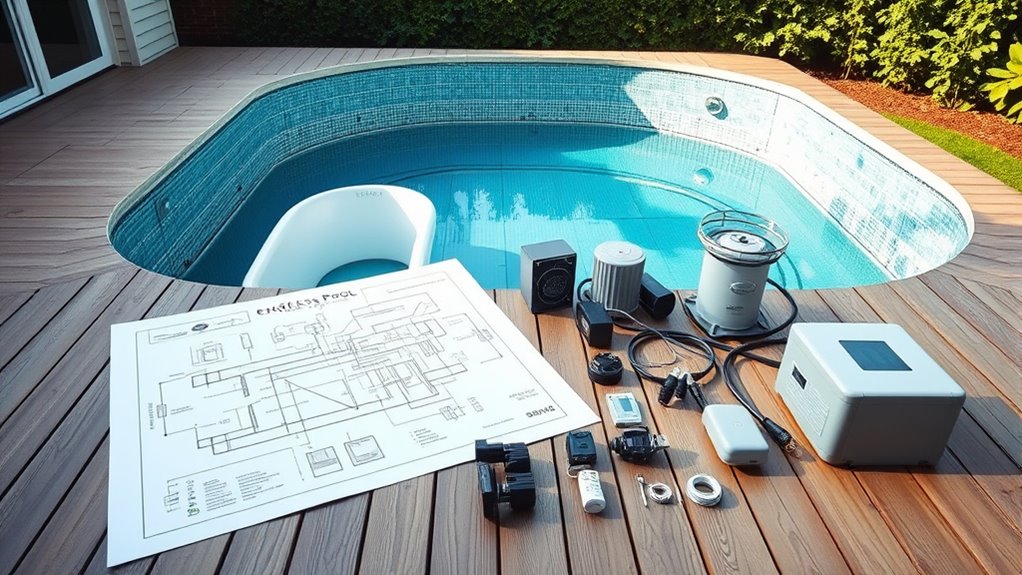
After preparing a solid, level foundation for your pool, the next step is choosing the right equipment and features to enhance your swimming experience. Start by selecting a reliable filtration system to keep the water clean and clear. Consider energy-efficient pumps and filters that reduce running costs. Next, think about the heating options—whether a heater or heat pump—to extend your swimming season comfortably. You might also want to add features like LED lighting for ambiance or a built-in sound system for entertainment. If space allows, consider adding a swim current generator to improve your workout. Finally, select safety features such as a cover or alarm system to protect your investment and ensure peace of mind. Proper equipment and thoughtful features make your pool enjoyable and functional year-round, and choosing compatible sprayer accessories can help with maintenance and repairs to keep your pool equipment functioning smoothly.
Installing the Pool System and Infrastructure
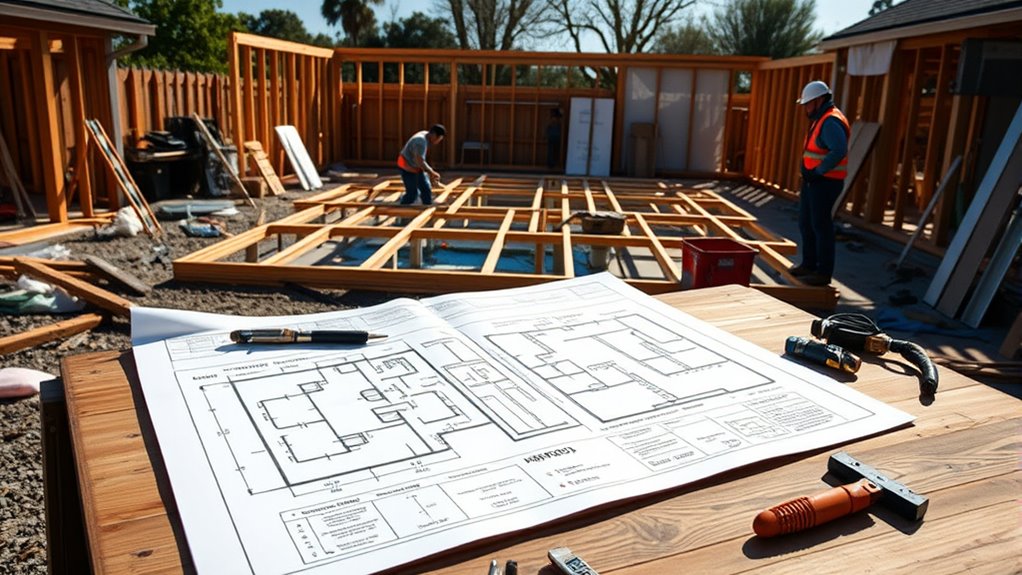
Installing the pool system and infrastructure requires careful planning and precise execution to guarantee everything functions properly. First, you’ll need to connect the filtration and pump systems, ensuring all plumbing is secure and leak-free. Second, install the electrical components, such as wiring for the pump, heater, and control panels, following local safety codes. Finally, set up the necessary support structures, like foundation pads or framing, to stabilize the pool and equipment. Pay close attention to proper pipe placement and secure connections, avoiding potential leaks or malfunctions. Confirm all electrical connections are correctly grounded and protected. Ensuring high-quality components are used can improve the durability and efficiency of your system. Completing these steps thoroughly helps prevent future issues, ensuring your pool operates smoothly and safely from the moment you fill it for the first swim.
Filling, Testing, and Fine-Tuning Your Pool
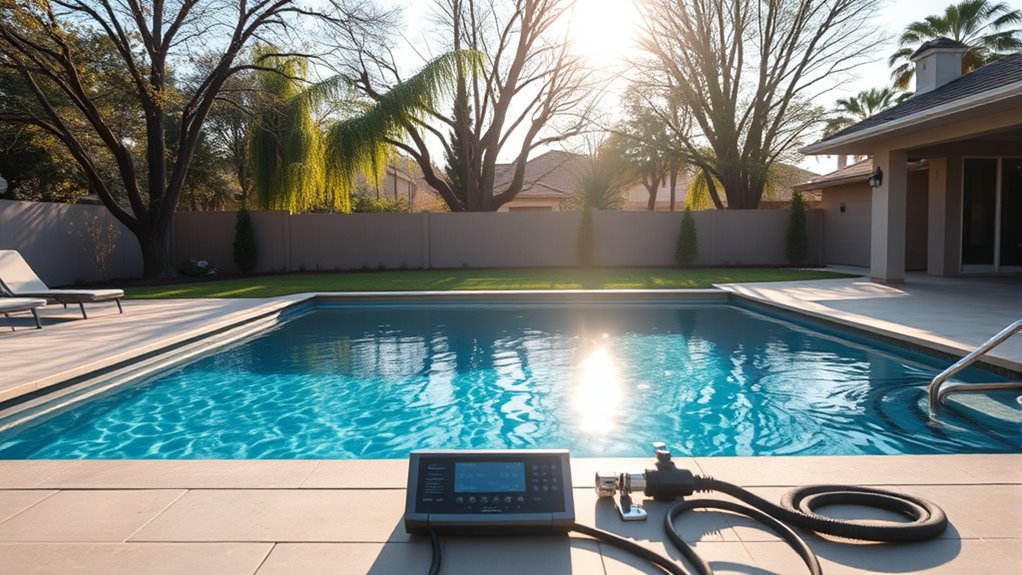
Once your pool system is set up and all connections are secure, it’s time to begin filling the pool with water. Use a garden hose or a dedicated fill line, ensuring a steady flow to prevent airlocks or uneven filling. As the water level rises, check that all valves and fittings stay secure and leak-free. Once filled, turn on the pump and filtration system to circulate the water. Observe the system for proper operation, listening for unusual noises and watching for leaks. Test the water’s pH, alkalinity, and sanitizer levels, adjusting as needed to reach recommended ranges. Fine-tune your system by balancing chemicals and ensuring filters are clean. This process guarantees clean, safe water and peak performance before your first swim.
Getting Ready for Your First Swim

With the water level and chemical balance now optimized, you’re ready to prepare for your first swim. First, ensure the area around your pool is clear of debris and obstacles, creating a safe environment. Next, check that your pool’s filtration system is running smoothly to keep the water clean and clear during your swim. Finally, gather your essentials—towels, pool shoes, and any accessories—so you’re ready to jump in comfortably. Visualize stepping into the warm water, feeling the gentle current and the soothing sensation on your skin. Take a moment to relax, breathe deeply, and enjoy the anticipation. Your pool is now ready to offer a revitalizing, enjoyable experience the very first time you immerse yourself.
Frequently Asked Questions
How Long Does the Entire Installation Process Typically Take?
The entire installation usually takes about one to two weeks, depending on factors like site preparation and permits. You’ll start with planning and site setup, which can take a few days, then move on to actual installation, often completed within a few days. If your project involves complex electrical or plumbing work, it might extend slightly. Stay in contact with your installer to keep everything on schedule.
What Maintenance Is Required After Installation?
After installation, you’ll want to regularly clean the filter, check chemical levels, and inspect the pump and heater for proper function. You should also skim the surface for debris, scrub the walls and tiles periodically, and monitor water quality to prevent algae growth. Routine maintenance keeps your pool inviting, guarantees peak performance, and extends its lifespan—making every swim safe, clean, and enjoyable.
Can I Install an Endless Pool Indoors?
Yes, you can install an endless pool indoors. Just make sure your space has adequate ceiling height, proper ventilation, and sufficient access for installation and maintenance. You’ll need to take into account flooring support and waterproofing to prevent damage. Measure your space carefully, and consult with professionals to ensure compliance with local building codes. Once installed, you’ll enjoy convenient, private swimming without weather concerns or travel time.
What Are the Energy Costs Associated With Running the Pool?
The energy costs of running your endless pool depend on factors like size, heater type, and usage. Typically, expect to spend between $20 and $50 monthly on electricity if you use the pool regularly. To save energy, consider installing a cover to retain heat and using energy-efficient pumps. Monitoring your usage and maintaining equipment properly can also help keep costs manageable.
How Long Does It Take to Warm up the Pool Water?
Think of warming your pool like a sunrise slowly brightening the sky. It typically takes 8 to 12 hours for the water to reach your desired temperature, depending on factors like initial temperature, heater size, and ambient weather. If you plan ahead and keep your heater on, you can enjoy a comfortably warm pool in the morning. For faster results, preheat overnight or use a cover to trap heat effectively.
Conclusion
Building your endless pool is like planting a seed—you put in effort, patience, and care, and soon, you’ll enjoy the rewarding sight of your own backyard oasis. Remember, every step you take brings you closer to that first swim, where the worries of the day melt away. With careful planning and dedication, your dream pool becomes a reality—a peaceful retreat you’ll cherish for years to come. Immerse yourself and enjoy every moment!

